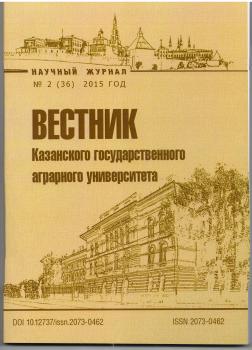The aim of our research was to increase the productive and reproductive qualities of geese breeders by crossing the white Hungarian and Kuban rocks. To achieve this aim, we should solve the following problems: to study the economically advantageous features of geese flocks of different genotypes and to calculate the cost-effectiveness of the research results. Materials and methods. The experiments were carried out in the Limited company “Bashkirskaya ptitsa” of Blagovar district of Bashkortostan in 2009-2012 by geese flocks of white Hungarian, Kuban breeds and their crosses. To study the productive and reproductive qualities of geese flocks we formed four groups of 64 head of adult geese of first year at the rate of 3 to 1 gander goose. The first group was equipped with Hungarian white goose breeds, the second - the Kuban , the third - a cross between those, obtained by crossing the white Hungarian geese ganders with Kuban, and the fourth - a cross between the Kuban gander and white Hungarian geese. The research was carried out for 150 days. The process parameters and feeding of geese corresponded to VNITIP recommendations. According to the research, we found that the geese of III trial group (♂Hungarian × ♀ Kuban) outnumbered white peers of Hungarian breed and other groups in egg production by 9.6 and 2.2%, respectively, with 3.9% yielding Kuban. The highest content of carotinoids, vitamin A and B2 were found in the eggs of hybrid geese of III group, which amounted to, respectively, 16.05 mkg/g, 9.31 and 8.73 mkg/g. The highest number of conditional geese of first category had also cross-bred geese of third experimental group (♂Hungarian × ♀ Kuban) - 1,447 heads or 85.7%, which is 4.3, 5.9 and 2.2 % had more than a white Hungarian, Kuban breeds of geese and other crossbred groups. Output. Thus, due to the high egg production, the quality of hatching eggs and day-old chicks, the breeding of hybrid geese, obtained in crosses with a white Hungarian geese with Kuban rocks, yielded additional revenue of 119,751.7 rubles and increase profitability by 11.91% , compared with the parental forms Kuban breed geese.
white Hungarian and Kuban breed of geese, crossing, heterosis effect, egg production, the intensity of egg production, egg quality, category of daily goslings.
Введение. Промышленное птицеводство как самая наукоёмкая и динамичная отрасль агропромышленного комплекса вносит весомый вклад в обеспечение населения страны продовольствием. Она – основной поставщик высококачественного животного белка. За последние 20 лет среднегодовой прирост яиц и мяса птицы в мире превышает 4% [1].
Гусеводство – одно из направлений птицеводства, позволяющее производить мясо птицы с использованием значительного количества зеленых, сочных и грубых кормов при минимальных затратах концентрированных кормов [2].
Для повышения мясной продуктивности гусей актуальным является использование эффекта гетерозиса при скрещивании различных пород. Помесное потомство, как правило, превосходит родительские формы и имеет лучшее развитие, повышенную жизнеспособность и продуктивность.
В связи с вышеизложенным, целью наших исследований явилось повышение продуктивных и воспроизводительных качеств гусей родительского стада при скрещивании белой венгерской и кубанской пород. Для достижения данной цели были поставлены и решены следующие задачи: изучить хозяйственно-полезные признаки гусей родительского стада различных генотипов и рассчитать экономическую эффективность результатов проведенных исследований.
Условия, материалы и методы исследования. Опыты проводились в условиях ООО «Башкирская птица» Благоварского района Республики Башкортостан в 2009-2012 гг. на гусях родительского стада белой венгерской, кубанской пород и их помесях.
Для выявления лучших сочетающихся линий в исследованиях использовали реципрокное скрещивание, общая схема которых представлена в таблице 1.
С целью изучения продуктивных и воспроизводительных качеств гусей родительского стада было сформировано 4 группы по 64 головы взрослых гусей первого года использования из расчета на 1 гусака 3 гусыни. Первая группа была укомплектована гусями белой венгерской породы, вторая – кубанской, третья - помесями, полученными при скрещивании белых венгерских гусаков с кубанскими гусынями, и четвертая – помесями кубанских гусаков и белых венгерских гусынь.
Исследования проводили в течение 150 дней.
Технологические параметры содержания и кормления гусей соответствовали рекомендациям ВНИТИП.
Анализ и обсуждение результатов. Яйценоскость – основной селекционный признак и решающий показатель яичной продуктивности гусей, поскольку определяет их плодовитость, то есть в конечном итоге количество реализуемых гусят и мяса, получаемого от потомства одной гусыни [3]. В таблице 2 представлена яйценоскость гусей на среднюю несушку.
1. Fisinin V.I. Ptitsevodstvo Rossii - strategiya innovatsionnogo razvitiya / RASKhN, VNITIP.- Moskva.-2009.-148s.
2. Kovatskiy N.S., Tsoy V.G., Saitbatalov T.F. Gusevodstvo /NPTs «Serafimovskaya pushinka».-Moskva.-2004.-188s.
3. Kochish I.I., Petrash M.G., Smirnov S.B. Ptitsevodstvo / Pod. red. I.I.Kochisha.- 2-e izd., pererab. i dop. - M.: KolosS.-2007. -414 s.
4. Ageechkin A.P., Alekseev F.F., Aralov A.V. i dr. Promyshlennoe ptitsevodstvo. - Sergiev Posad.-2010.- 600s.
5. Gadiev R.R., Gerasimova L.V. Biologicheskiy kontrol' pri inkubatsii yaits sel'skokhozyaystvennoy ptitsy.- Ufa.- 2006.-108s.
6. Galina Ch.R., Gadiev R.R. Produktivnye kachestva gusey razlichnykh genotipov// Vestnik Bashkirskogo gosudarstvennogo agrarnogo universiteta. 2012. № 4. S. 33-36.





